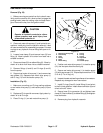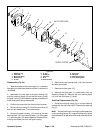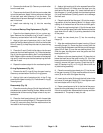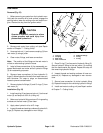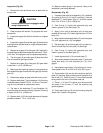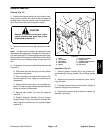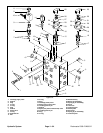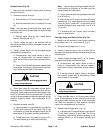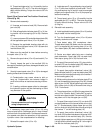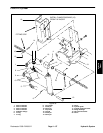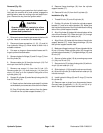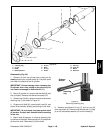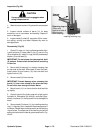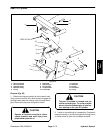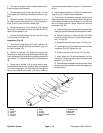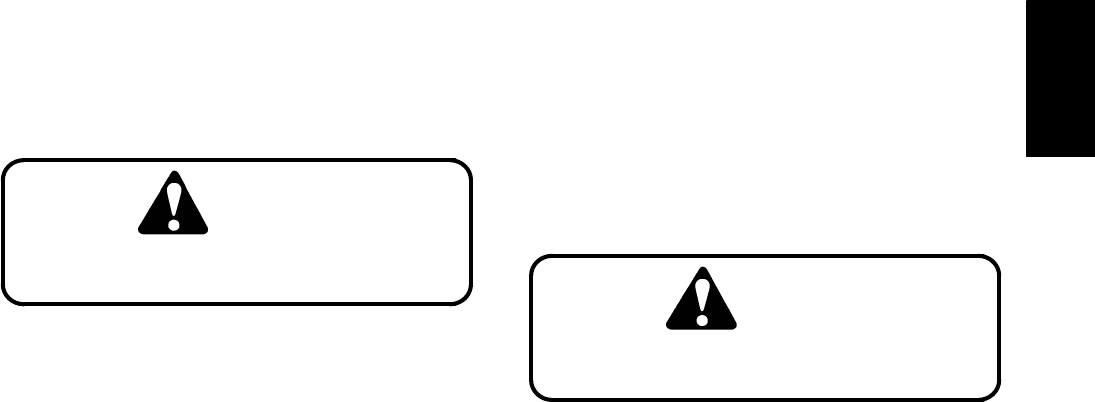
Reelmaster 2300–D/2600–D Hydraulic SystemPage 4 – 65
Solenoid Valve (Fig. 58)
1. Make sure the manifold is clean before removing
the spool valve (8).
2. Remove the spool valve (8):
A. Remove the nut (11) from the spool valve (8).
B. Remove the solenoid coil (10) and both O–rings
(9).
Note: Use care when handling the spool valve. slight
bending or distortion of the stem tube can cause binding
and malfunction.
C. Remove spool valve (8) with a deep socket
wrench. Remove seal kit (7).
3. Visually inspect the port in the manifold (22) for
damage to the sealing surfaces, damaged threads, and
contamination.
4. Visually inspect spool valve for damaged sealing
surfaces and contamination.
A. Contamination may cause valves to stick or
hang up. Contamination can become lodged in
small valve orifices or seal areas causing malfunc-
tion.
B. If spool valve (8) sealing surfaces appear pitted
or damaged, the hydraulic system may be overheat-
ing or there may be water in the system.
CAUTION
Use eye protection such as goggles when
using compressed air
5. Clean spool valve (8) using clean mineral spirits.
Submerge valve in clean mineral spirits to flush out con-
tamination. Use a probe to push the internal spool in and
out 20 to 30 times to flush out contamination. Particles
as fine as talcum powder can affect the operation of high
pressure hydraulic valves. Use compressed air for
cleaning.
6. Reinstall the spool valve (8):
A. Lubricate new O–ring and backup ring of seal kit
(7) with clean hydraulic oil and install. The O–ring
and backup ring must be arranged properly on the
spool valve (8) for proper operation and sealing.
B. Thread spool valve (8) carefully into port (S1).
The valve should go in easily without binding.
Note: Use care when handling the spool valve (8).
slight bending or distortion of the stem tube can
cause binding and malfunction.
C. Torque spool valve (8) using a deep socket to 35
ft–lb (4.8 kg–m).
D. Make sure a new O–ring (9) is at each end of the
solenoid coil (10). install solenoid coil to the spool
valve (8). Apply ”Loctite 242” or equivalent to the
threads of the spool valve: torque nut (11) to 15 in–lb
(17 kg–cm).
E. If problems still exit, remove valve and clean
again or replace valve.
Cartridge (Logic and Relief) Valves (Fig. 58)
1. Make sure the manifold is clean before removing
the cartridge valve (1 or 14) and seal kit (2 or 7).
2. Remove the cartridge valve (1 or 14).
3. Visually inspect the port in the manifold (22) for
damage to the sealing surfaces, damaged threads, and
contamination.
4. Visually inspect cartridge valve (1 or 14) for dam-
aged sealing surfaces and contamination.
A. Contamination may cause valves to stick or
hang up. Contamination can become lodged in
small valve orifices or seal areas causing malfunc-
tion.
B. If sealing surfaces appear pitted or damaged,
the hydraulic system may be overheating or there
may be water in the system.
CAUTION
Use eye protection such as goggles when
using compressed air
5. Clean cartridge valve (1 of 14) using clean mineral
spirits. Submerge valve in clean mineral spirits to flush
out contamination. Particles as fine as talcum powder
can affect the operation of high pressure hydraulic
valves. Use compressed air for cleaning.
6. Reinstall the cartridge valve (1 or 14):
A. Lubricate new O–ring and backup ring of seal kit
(7) with clean hydraulic oil and install. The O–ring
and backup ring must be arranged properly on the
cartridge valve (1 or 14) for proper operation and
sealing.
Hydraulic
System



